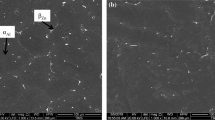Abstract
The electrochemical behaviour of Al–x%Zn alloys (1 wt% ≤ x ≤ 80 wt% ) was studied in 0.5 m sodium chloride solution. The experiments focused on the influence of casting conditions on sacrificial anode performance. The influence of casting conditions, solidification structure, polarization behaviour and attack morphology on the anode efficiency and operating potential was analysed. For alloys with low Zn content (1–5 wt%), the interdendritic zones or grain boundaries were the initial sites of attack and self corrosion was the principal cause of efficiency loss. Particularly, for Zn contents below 3 wt% the operating potential was strongly affected by the solidification macrostructure. Casting conditions that produced better alloying element distribution (chill structures) promoted higher anode efficiency. For Zn content higher than 5 wt% the operating potential and the anode efficiency were defined by the α/β phases area relationship.
Similar content being viewed by others
References
M.G. Flemings, 'Solidification Processing' (McGraw-Hill, New York, 1974).
J.T. Reading and J.J. Newport, Mater. Protect. 5 (1966) 15.
D.R. Salinas and J.B. Bessone, Corrosion 47 (1991) 665.
J.B. Bessone, R.A. Suarez Baldo and S.M. de De Micheli, Corrosion 37 (1981) 533.
J. Morgan, `Cathodic Protection' (NACE, 1995), chapter 4. p. 113.
L.L. Shreir, `Corrosion', Vol. 2 (Butterworths, London 1978), p. 11–21.
P.R. Sperry and M.H. Bankard, Metallographie Techniques for Aluminum Alloys, in `Metals Handbook', 8th edn., Vol. 8, (ASM, Metals Park, OH, 1973), p. 120.
D.T. Hawkins and R. Hultgren, Constitution of Binary Alloys, in `Metals Handbook', 8th edn., Vol. 8, (ASM, Metals Park, OH, 1973), p. 265.
A. Zahra, C.Y. Zahra and R. Ciach, J. Thermal Anal. 26 (1983) 303.
J.R. Scott and H. Lee Craig, Jr, Proceedings 4th NACE Meeting (1971), p. 179.
G. KnoÈ rnschild, J. Heldt, H. Mitterbacher and H. Kaesche, Werkst. Korros. 46 (1995) 572.
I.L. MuÈ ller and J.R. Galvele, Corr. Sci. 17 (1977) 995.
D.H. Hooton and N.E. Giorgetta, X-Ray Spectrom. 6 (1977) 2.
Author information
Authors and Affiliations
Rights and permissions
About this article
Cite this article
Salinas, D., García, S. & Bessone, J. Influence of alloying elements and microstructure on aluminium sacrificial anode performance: case of Al–Zn. Journal of Applied Electrochemistry 29, 1063–1071 (1999). https://doi.org/10.1023/A:1003684219989
Issue Date:
DOI: https://doi.org/10.1023/A:1003684219989




